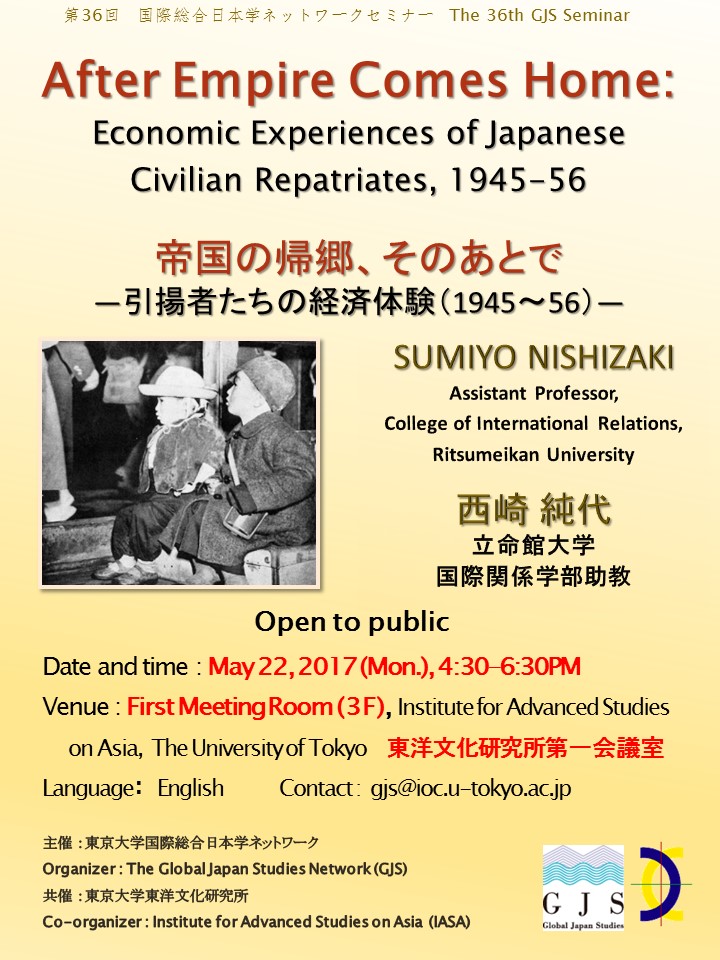第36回GJSセミナー帝国の帰郷、そのあとで―引揚者たちの経済体験(1945~56)―
| 日時: | 2017年5月22日(月)16:30~18:30 |
|---|---|
| 会場: | 東京大学東洋文化研究所 第一会議室(3階) |
| 発表者: | 西崎 純代(立命館大学国際関係学部助教) |
| 使用言語: | 英語 |

発表概要: The economic impact of large influxes of population is a complex topic. This research contributes to this field by examining one of the most significant, but least researched, examples of postwar migration – the repatriation of more than six million (including three million civilians and demobilized soldiers each) to Japan after the Second World War. One pervasive image of Japanese civilian repatriates is that of the immigrant farmer of Manchuria (Manshū kaitakumin) who settled as a part of Japan’s Manchurian policies and had difficult repatriation experiences under the hostility of local people. However, many returned from other regions as well, including Korea and Sakhalin, and repatriates consisted of not only farmers but also colonial government officials, employees of public and private corporations, and small business owners, amongst others. This research uses an analysis of statistical data, which is a unique approach to study Japanese repatriation. A core source material is a national survey into civilian repatriates’ postwar lives (Zaigai jijitsu chōsahyō) conducted by the Ministry of Health and Welfare in 1956, and focuses on civilian repatriates’ occupational changes during the time of economic transition.
The most unexpected finding in my research was that roughly half of civilian repatriates had worked in the public or semi-public sectors, or major Japanese firms’ overseas branches in the Japanese empire. Repatriate farmers, who have become a symbol of the Japanese repatriate, were a minority, and made up only 5-10 % of overall Japanese civilian repatriates. The data presented in the research shows that, in contrast to prevailing notions, repatriates’ postwar settlement was facilitated by a) skilled employment, b) employment in the public or semipublic sectors, and c) family farming or employment in small businesses in the tertiary sector. As a result, despite the scale of the repatriation, the settlement was broadly successful. It can be argued that this type of transition helped to bring political and economic stability, which became a foundation of Japan’s postwar growth.
This finding has another important implication which is related to war memory creation. In postwar Japan, the majority of repatriates who had been associated with wartime public corporations or the wartime public sector appear not to have openly spoken of their experiences, fearing being labeled as the empire’s agents. On the contrary, the tragic experiences of repatriate farmers have caught the general public’s attention. The gap between the silence of the former group, and the often-heard stories of victims might have led to the recreation of images of ‘the repatriates’ which significantly emphasizes the experiences of the latter group. Consequently, although details of the repatriation problems have been largely forgotten, the imagery of the repatriates as victims of the war have been recreated and perpetuated among the Japanese general public. This settlement pattern offers a reasonable explanation as to why a large number of repatriates were able to be absorbed into postwar Japan and why the memories of the Japanese repatriation were largely forgotten, aside from selected images of the repatriates as victims of the war.
共催:東京大学東洋文化研究所(ISAS)
問い合わせ:gjs[at]ioc.u-tokyo.ac.jp



